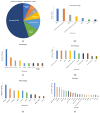The Promise of Nanotechnology in Personalized Medicine
- PMID: 35629095
- PMCID: PMC9142986
- DOI: 10.3390/jpm12050673
The Promise of Nanotechnology in Personalized Medicine
Abstract
Both personalized medicine and nanomedicine are new to medical practice. Nanomedicine is an application of the advances of nanotechnology in medicine and is being integrated into diagnostic and therapeutic tools to manage an array of medical conditions. On the other hand, personalized medicine, which is also referred to as precision medicine, is a novel concept that aims to individualize/customize therapeutic management based on the personal attributes of the patient to overcome blanket treatment that is only efficient in a subset of patients, leaving others with either ineffective treatment or treatment that results in significant toxicity. Novel nanomedicines have been employed in the treatment of several diseases, which can be adapted to each patient-specific case according to their genetic profiles. In this review, we discuss both areas and the intersection between the two emerging scientific domains. The review focuses on the current situation in personalized medicine, the advantages that can be offered by nanomedicine to personalized medicine, and the application of nanoconstructs in the diagnosis of genetic variability that can identify the right drug for the right patient. Finally, we touch upon the challenges in both fields towards the translation of nano-personalized medicine.
Keywords: nanomedicine; personalized medicine; pharmacogenetics; pharmacokinetics.
Conflict of interest statement
The authors declare no conflict of interest.
Figures




References
-
- Personalized Medicine. [(accessed on 17 March 2022)]; Available online: https://www.cancer.gov/publications/dictionaries/cancer-terms/def/person....
-
- Ventola C.L. The nanomedicine revolution: Part 1: Emerging concepts. Pharm. Ther. 2012;37:512.
Publication types
LinkOut - more resources
Full Text Sources

